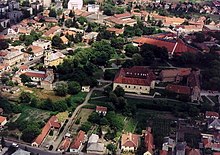Szerencs
| Szerencs | ||||
|
||||
| Basic data | ||||
|---|---|---|---|---|
| State : | Hungary | |||
| Region : | Northern Hungary | |||
| County : | Borsod-Abaúj-Zemplén | |||
| Small area until December 31, 2012 : | Szerencs | |||
| Coordinates : | 48 ° 10 ' N , 21 ° 12' E | |||
| Height : | 100 m | |||
| Area : | 36.69 km² | |||
| Residents : | 9,173 (Jan 1, 2011) | |||
| Population density : | 250 inhabitants per km² | |||
| Telephone code : | (+36) 47 | |||
| Postal code : | 3900 | |||
| KSH kódja: | 30739 | |||
| Structure and administration (as of 2012) | ||||
| Community type : | city | |||
| Mayor : | Ferenc Koncz | |||
| Postal address : | Rákóczi u. 89, 3900 Szerencs |
|||
| Website : | ||||
| (Source: A Magyar Köztársaság helységnévkönyve 2011. január 1st at Központi statisztikai hivatal ) | ||||
Szerencs [ sɛrɛnʧ ] (German: Serentsch ) is a Hungarian town in the county of Borsod-Abaúj-Zemplén , approximately 35 km east of Miskolc . It is also known as the gateway to the Tokaj-Hegyalja .
history
The place was first mentioned in 1216. After an anonymous source should Árpád , the Grand Duke of eight strains (seven Magyar tribes and Turkic and Khazar tribe: also fekete magyarok called "black Hungarians") with his army during the conquest in Pannonia on the Isten-hegy in northern Szerenc's camp. Árpád is said to have said the following: Ma ád Isten szerencsét e tájnak (“God give this area happiness today”). Hence the place names of the municipalities of Mád , Szerencs and Tállya .
There was a Benedictine abbey since 1247 , the building of which was converted into a castle in 1556. The castle (also called Rákóczi Castle (Rákóczi-vár) or Hussar Castle (Huszár-vár) ) was owned by the Rákóczi family from 1586 to 1616 and had to withstand several sieges during the Ottoman rule .
Here, Stephan Bocskai and Sigismund I. Rákóczi were elected princes of Transylvania by the Hungarian estates .
A small bridge west of the city on the railway line towards Sátoraljaújhely , not far from the village of Fecskés, is indicative of the senselessness and cruelty of the Second World War . This named bridge over the Máder Bach (Mádi-patak) measures 1.5 m or less and should be blown up by the Wehrmacht to prevent the advance of the Soviet troops . However, the bridge was not destroyed by heavy gunfire, only the surrounding fields were hit. The bridge has stood unchanged in the Puszta since then and represents a curious memorial in history.
Until the 1950s there was a synagogue in the community , which the socialist apparatus of power had torn down. A public building for the local LPG was built in their place . Only the Jewish cemetery remained. Szerencs and the neighboring municipality of Mád were important centers of Jewish communities before the Holocaust (the synagogue in Mád was restored between 2000 and 2004, financed by the World Monuments Fund ).
The Sinti and Roma make up a significant proportion of the population in the region. In everyday life they are exposed to racism , which has not improved after Hungary's accession to the EU. The number of illiterate people remains high, and the mostly low level of education results in high unemployment rates in this ethnic group.
Attractions
- Rákóczi Castle with the Zemplén Museum. Here you can also visit the world's third largest collection of postcards with a volume of almost 900,000 cards.
- Collection of Dr. László Petrokovics
- Szerencs Sugar Factory Museum
- Reformed Church. It was built in the 14th century and its bell dates from 1646. The grave monument of Prince Sigismund I Rákóczi and his wife is located here.
- Roman Catholic Church
- Greek Catholic Church. It was built by the Russians who settled here in the 18th century . The iconostasis extending over 6 levels is worth seeing .
Town twinning
-
 Geisenheim in Hesse (Rheingau)
Geisenheim in Hesse (Rheingau) -
 Hesperange in Luxembourg
Hesperange in Luxembourg -
 Malchin in Mecklenburg-Western Pomerania
Malchin in Mecklenburg-Western Pomerania -
 Miercurea Nirajului in Romania
Miercurea Nirajului in Romania -
 Podgora in Croatia
Podgora in Croatia -
 Rožňava in Slovakia
Rožňava in Slovakia
Personalities
- Georg I. Rákóczi (1593–1648), Prince of Transylvania
- Ferenc Fülep (1919–1986), archaeologist and museum director, born in Szerencs




